 Whether you’re running a small business or a big brand, you can reap great benefits when a highly influential person talks about your business. It can help you drive traffic to your site, increase your SEO and build your online social standing.
Whether you’re running a small business or a big brand, you can reap great benefits when a highly influential person talks about your business. It can help you drive traffic to your site, increase your SEO and build your online social standing.
You need to be efficient with your time and even more effective with whom you choose to connect with. You want to be able to connect with industry influencers – people who have a success story, speak at conventions, widely published and well respected.
Here are a few tips for connecting with industry influencers on social media. Read on for a simple system you can immediately deploy.
Find your influencers
The first thing you need to do is to find your influencers. Industry influencers are industry experts and thought leaders that have a following that is similar to what you want to achieve. When looking at an influencer, take into account their search engine ranking, Klout score and number of followers.
Interact with them actively
Keep an eye out for influencers for chances to reach out. Interact with them through contents they are sharing. Feel free to ask a question if you think a particular point they’re making requires further explanation, show your appreciation for an article they have written or share their work through social media. Whatever you do, be genuine.
Nurture the relationship
Once you’ve engaged with an influencer, be sure to keep the lines of communication open and reach out to them once in a while. Take the initiative to strike up a conversation. Send them an email to let them know about a campaign you’re running or invite them to events you’re hosting. If you see you can provide assistance, do it. This can help grow your relationship and build trust with the influencer.









